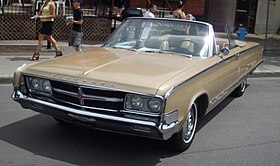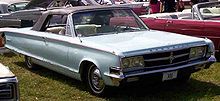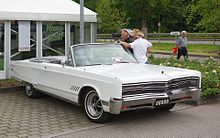
The Buick Skylark is a passenger car formerly produced by Buick. The model was made in six production runs, during 46 years, over which the car's design varied dramatically due to changing technology, tastes, and new standards implemented over the years. It was named for the species of bird called skylark.

The Chrysler 300 "letter series" are high-performance personal luxury cars that were built by Chrysler in the U.S. from 1955 to 1965 and were a sub-model from the Chrysler New Yorker. After the initial year, which was named C-300 for its standard 300 hp (220 kW) 331 cu in (5.4 L) FirePower V8, the 1956 cars were designated 300B. Successive model years were given the next letter of the alphabet as a suffix, reaching the 300L by 1965, after which the model sequence was discontinued while the "300" remained. At its introduction it was advertised as "America's Most Powerful Car".

The Chevrolet Bel Air is a full-size car produced by Chevrolet for the 1950–1981 model years. Initially, only the two-door hardtops in the Chevrolet model range were designated with the Bel Air name from 1950 to 1952. With the 1953 model year, the Bel Air name was changed from a designation for a unique body shape to a premium level of trim applied across a number of body styles. The Bel Air continued with various other trim level designations, and it had gone from a mid-level trim car to a budget fleet sedan when U.S. production ceased in 1975. Production continued in Canada, for its home market only, through the 1981 model year.
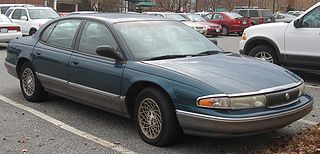
The Chrysler New Yorker is an automobile model that was produced by Chrysler from 1940 until 1996, serving for several decades as either the brand's flagship model or as a junior sedan to the Chrysler Imperial, the latter during the years in which the Imperial name was used within the Chrysler lineup rather than as a standalone brand.

The Dodge Dart is a line of large passenger cars produced by Dodge from the 1959 to 1976 model years in North America, with production extended to later years in various other markets.

The Dodge Monaco is an automobile that was marketed by the Dodge division of Chrysler Corporation. Introduced as the flagship of the Dodge product line, the Monaco was introduced for 1965 to replace the Custom 880, then later joining as a sub-model of the Dodge Polara. During its production, the Monaco was offered in multiple body configurations, including two-door and four-door hardtop sedans, four-door sedans, two-door convertibles, and station wagons.

The Dodge Coronet is an automobile that was marketed by Dodge in seven generations, and shared nameplates with the same bodyshell with varying levels of equipment installed. Introduced as a full-size car in 1949, it was the division's highest trim line and moved to the lowest level starting in 1955 through 1959. The name was reintroduced on intermediate-sized models from the 1965 until 1976 model years. Muscle car versions were available starting in 1965 with the 383 and 426 wedge cu in Chrysler RB engine, followed in 1966 by the powerful 426 cu in Chrysler Hemi. Other performance models included the "Superbee", and featured, the 383 cu in Magnum, among other engine options. The nameplate "coronet" is a type of crown worn by royalty.

The Plymouth Fury is a model of automobile that was produced by Plymouth from 1955 until 1989. It was introduced for the 1956 model year as a sub-series of the Plymouth Belvedere, becoming a separate series one level above the contemporary Belvedere for 1959. The Fury was a full-size car from 1959 until 1961, then a mid-size car from 1962 until 1964, again, a full-size car from 1965 through 1974, and again, a mid-size car from 1975 through 1978. From 1975 until 1977, the Fury was sold alongside the full-size Plymouth Gran Fury. In 1978, the B-body Fury was the largest Plymouth, and by 1979, there was no large Plymouth. This product gap was filled in 1980 with the R-body Gran Fury, followed by the M-body Fury in 1982. Production of the last V8, RWD Plymouth Fury ended at the Kenosha Main assembly plant in Kenosha, WI, on December 23, 1988. Unlike its sibling brand, Dodge, Plymouth would not live to see the resurgence of the large, V8/RWD sedan.

The Plymouth Belvedere is a series of American automobile models made by Plymouth from 1954 until 1970.

The Chrysler Saratoga is an automobile built by Chrysler. The nameplate was used from 1939 to 1952 and from 1957 to 1960 in the U.S. market, in Canada through 1965, and in Europe from 1989 to 1995. In the beginning, it was introduced as a sport luxury model, using the Straight Eight engine from the Chrysler New Yorker which was more formal, and the Imperial which had graduated to special order limousine.
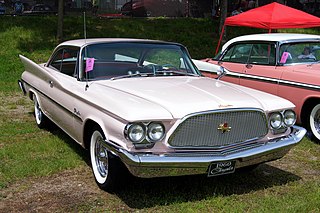
The Chrysler Windsor is a full-size car which was built by Chrysler from 1939 through to the 1960s. The final Chrysler Windsor sold in the United States was produced in 1961, but production in Canada continued until 1966. The Canadian 1961 to 1966 Windsor model was for all intents and purposes the equivalent of the Chrysler Newport in the United States.

The Ford Fairlane is an automobile model that was sold between the 1955 and 1970 model years by Ford in North America. Taking its name from the Dearborn, Michigan estate of Henry Ford, the Fairlane nameplate was used for seven different generations of vehicles. Through its production, the model line would be marketed in a wide variety of body styles, including two-door and four-door sedans, two-door and four-door hardtops, station wagons, and both traditional and retractable-hardtop convertibles.

The Plymouth Satellite is a mid-size automobile introduced in the 1965 model year as the top trim model in Plymouth's "B" platform Belvedere line. Available initially in two-door hardtop and convertible models, the Satellite remained the top-of-the-line model until the 1967 model year. A station wagon version was added and a higher "Sport" trim introduced.

The Dodge Polara is an automobile introduced in the United States for the 1960 model year as Dodge's top-of-the-line full-size car. After the introduction of the Dodge Custom 880 in 1962, the Polara nameplate designated a step below the full-sized best-trimmed Dodge model; the Polara that year had been downsized to what was in effect intermediate, or mid-size status. In its various forms, the Polara name was used by Dodge until 1973, when its position in Dodge's line-up was replaced by the Dodge Monaco.

The Newport was a name used by Chrysler for both a hardtop body designation and also for its lowest priced model between 1961 and 1981. Chrysler first used the Newport name on a 1940 show car, of which five vehicles were produced. From 1950 to 1956, the Newport name was then used to designate any Chrysler model with a hardtop body style. In 1961, Chrysler introduced the Newport as a new, low-priced model, offering large, comfortable two- and four-door Chrysler models that were modestly priced compared with the Chrysler 300, the Chrysler New Yorker and the Imperial. For 1961, the Newport was priced below the Chrysler Windsor in the Windsor's final year.

The DeSoto Firedome was a full-size automobile produced between 1952 and 1959 by the DeSoto division of the Chrysler Corporation. Introduced as DeSoto's premium line of vehicles for the 1952 model year, it retained that position until demoted to the least expensive model for 1955. It was reclassified to become a mid-range vehicle for 1957 and was discontinued for the 1960 model year.

The DeSoto Adventurer is a full-sized automobile that was produced by DeSoto from 1956 through the 1961 model year. Introduced as a four-seat high-performance sports coupe concept car, the Adventurer ended up being DeSoto's special, limited-production, high-performance model, similar to the more luxurious and exclusive "letter series" Chrysler 300 and Chrysler Saratoga.

The Ford Falcon is a model line of cars that was produced by Ford from the 1960 to 1970 model years. Though preceded by the Rambler American, the Falcon was the first compact car marketed by the Big Three American manufacturers.

The Mercury Monterey is a series of full-size cars that were manufactured and marketed by the Mercury division of Ford from 1950 to 1974. Deriving its name from Monterey Bay, the initial Mercury Monterey served as the top-of-the-line two-door sedan model for 1950 and 1951 to compete with the hardtop models of Oldsmobile and Buick. It came with a vinyl roof covering, upgraded upholstery, and other features. The hardtop was introduced for 1952. During its production, the Monterey would be offered in multiple body styles, ranging from coupes, convertibles, sedans, hardtops, and station wagons.
The Dodge 440 is a mid-size car that was marketed by Dodge from 1962 to 1964.





